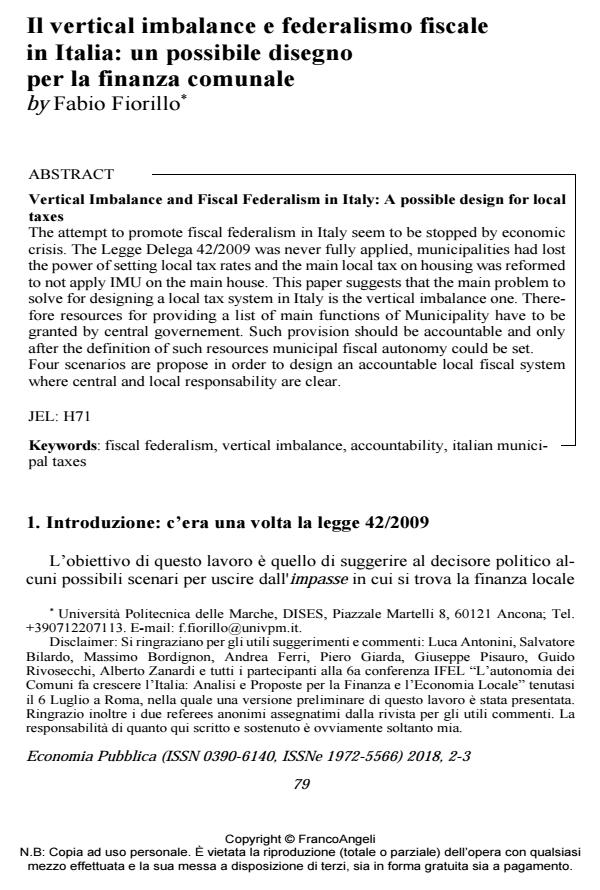Vertical Imbalance and Fiscal Federalism in Italy: A possible design for local taxes
Journal title ECONOMIA PUBBLICA
Author/s Fabio Fiorillo
Publishing Year 2018 Issue 2018/2-3
Language Italian Pages 28 P. 79-106 File size 338 KB
DOI 10.3280/EP2018-002004
DOI is like a bar code for intellectual property: to have more infomation
click here
Below, you can see the article first page
If you want to buy this article in PDF format, you can do it, following the instructions to buy download credits

FrancoAngeli is member of Publishers International Linking Association, Inc (PILA), a not-for-profit association which run the CrossRef service enabling links to and from online scholarly content.
The attempt to promote fiscal federalism in Italy seem to be stopped by economic crisis. The Legge Delega 42/2009 was never fully applied, municipalities had lost the power of setting local tax rates and the main local tax on housing was reformed to not apply IMU on the main house. This paper suggests that the main problem to solve for designing a local tax system in Italy is the vertical imbalance one. Therefore resources for providing a list of main functions of Municipality have to be granted by central governement. Such provision should be accountable and only after the definition of such resources municipal fiscal autonomy could be set. Four scenarios are propose in order to design an accountable local fiscal system where central and local responsability are clear.
Keywords: Fiscal federalism, vertical imbalance, accountability, italian municipal taxes
Jel codes: H71
- ACoFF – Alta commissione per la definizione dei meccanismi strutturali del federalismo fiscale (2005). Relazione sull’attività svolta dall’Alta commissione per la definizione dei meccanismi strutturali del federalismo fiscale. Ministero dell’economia e delle finanze (mimeo).
- In: Guerra M.C. e Zanardi A. (a cura di). La finanza pubblica italiana. Rapporto 2009. il Mulino.
- Bartolini D., Sacchi A., Salotti S., Santolini, R. (2017). Fiscal decentralization in times of financial crises. CESifo Economic Studies, in press.
- Bordignon M. (2013). Economic Crisis and Recentralization of Government: the Italian Experience. In: Bosch N. and Albert S. (ed.). IEB’s Report on Fiscal Federalism ’12. Barcellona.
- De Mello L. (2000). Fiscal decentralization and intergovernmental fiscal relations: A cross-country analysis. World Development 28(2): 365-380.
- Fausto D. (2003). Il federalismo fiscale nel paese del dualismo. In: Fossati, A. (a cura di). La nascita del federalismo italiano. Attuazione e riforma del titolo V della Costituzione. FrancoAngeli, 57-84.
- Fiorillo F. e Romano D. (2013). Alcuni profili economici della riforma IMU: un case study su Ancona e Senigallia. Economia Marche Journal of Applied Economics, XXXII(1).
- Gandullia L. e Taddei A. (2017a). Il fondo di solidarietà 2017: effetti e sostenibilità per i comuni italiani. Working Paper presentato alla 29esima conferenza SIEP.
- Gandullia L. e Taddei A. (2017b). Quella pesantezza del Fondo di solidarietà comunale. La Voce, 27 dicembre. -- www.lavoce.info.
- Giarda P. (2001). Le regole del federalismo fiscale nell’articolo 119: un economista di fronte alla nuova Costituzione. Le Regioni, dicembre. DOI: 10.1443/5621
- Giarda P. (2005). L’esperienza italiana di federalismo fiscale. Bologna: il Mulino.
- Goodspeed T. J. (2002). Bailouts in a federation. International Tax and Public Finance 9(4): 409-421. DOI: 10.1023/A:1016563902580
- Keen M. (1998). Vertical Tax Externalities in the Theory of Fiscal Federalism. IMF Staff Papers, 45(3). DOI: 10.2307/3867412
- Lattarulo P. e Petretto A. (2015a). Verso l’istituzione della Local Tax in Italia. IV Conferenza sulla Finanza e l’Economia Locale. Roma 24-25 giugno.
- Lattarulo P. e Petretto A. (2015b, a cura di). Local Tax: ipotesi a confronto. Studi e approfondimenti, IRPET.
- Marchionni E. Pollastri C. e Zanardi A. (2017). Fabbisogni standard e capacità fiscali nel sistema perequativo dei Comuni. UPB Nota di lavoro, 1.
- Musgrave R. A. (1959). The Theory of Public Finance: A Study in Public Economy.
- Musgrave R. (1983). Who Should Tax, Where and What?. In McLure C. (a cura di). Tax Assignment in Federal Countries. Centre for Research on Federal Financial Relations, Australian National University.
- Neyapti B. (2010). Fiscal decentralization and deficits: International evidence. European Journal of Political Economy, 26(2): 155-166.
- Oates W. E. (1972). Fiscal federalism. New York: Harcourt Brace Jovanovich.
- Oates W. (1996). Taxation in a federal system: The tax-assignment problem. Public Economics Review. Petretto A. (2003). Le entrate delle Regioni e degli Enti Locali secondo il nuovo art. 119 della Costituzione: un’analisi economica. IRPET Interventi, note e rassegne n. 19/03.
- Puviani A. (1903). Teoria dell’illusione finanziaria.
- Rodden J. (2002). The dilemma of fiscal federalism: Grants and fiscal performance around the world. American Journal of Political Science, 46(3): 670-687. DOI: 10.2307/3088407.
- Ter-Minassian T. (1997). Decentralization and macroeconomic management. IMF Working Paper No. 97/155. DOI: 10.5089/9781451857276.001
- Arachi G. e Zanardi A. (2009). La perequazione delle Regioni e degli Enti Locali.
- Real-Time Collection of the Value-Added Tax: Some Business and Legal Implications Richard Thompson Ainsworth, Boryana Madzharova, in SSRN Electronic Journal /2012
DOI: 10.2139/ssrn.2166316
Fabio Fiorillo, Il vertical imbalance e federalismo fiscale in Italia: un possibile disegno per la finanza comunale in "ECONOMIA PUBBLICA " 2-3/2018, pp 79-106, DOI: 10.3280/EP2018-002004